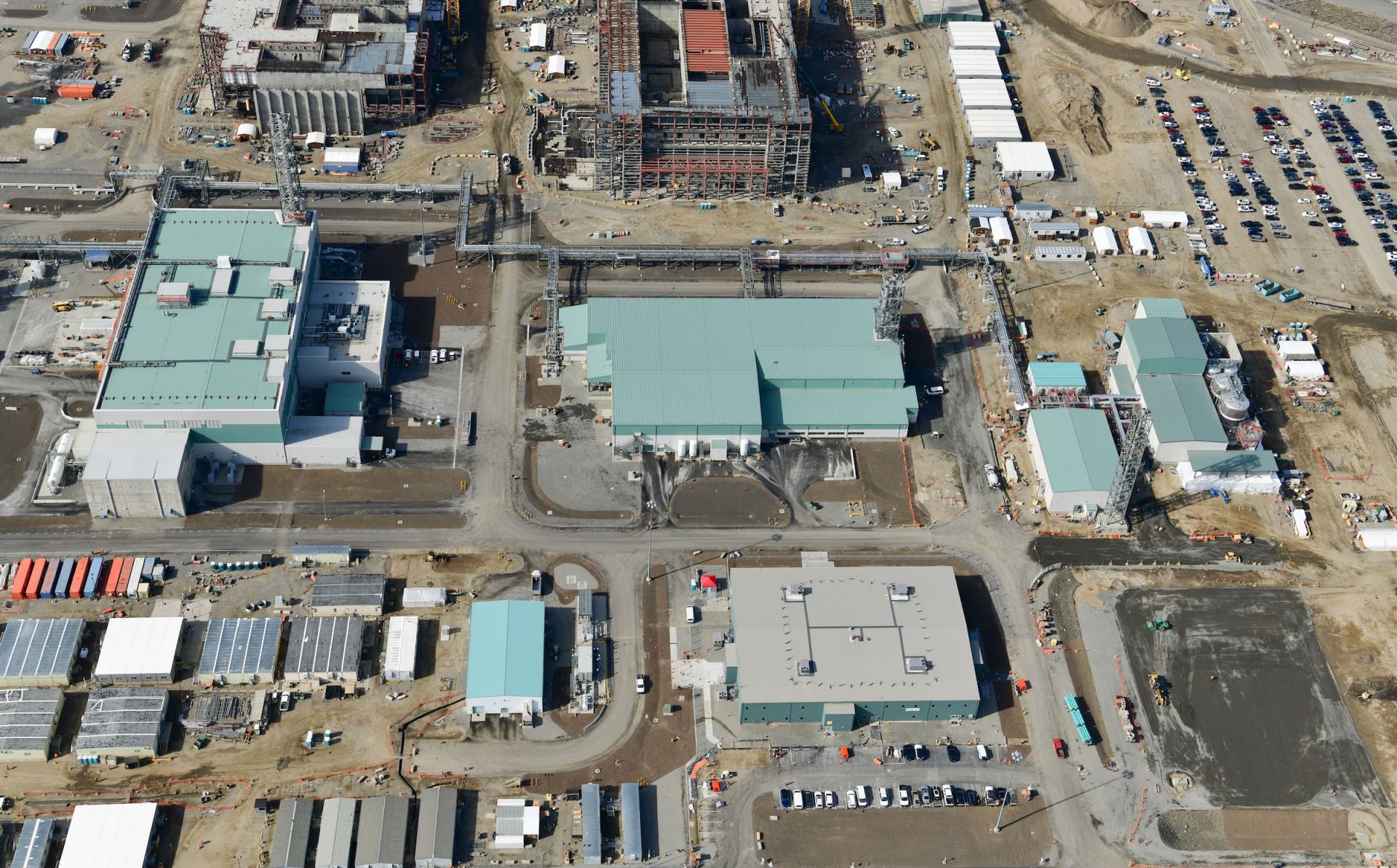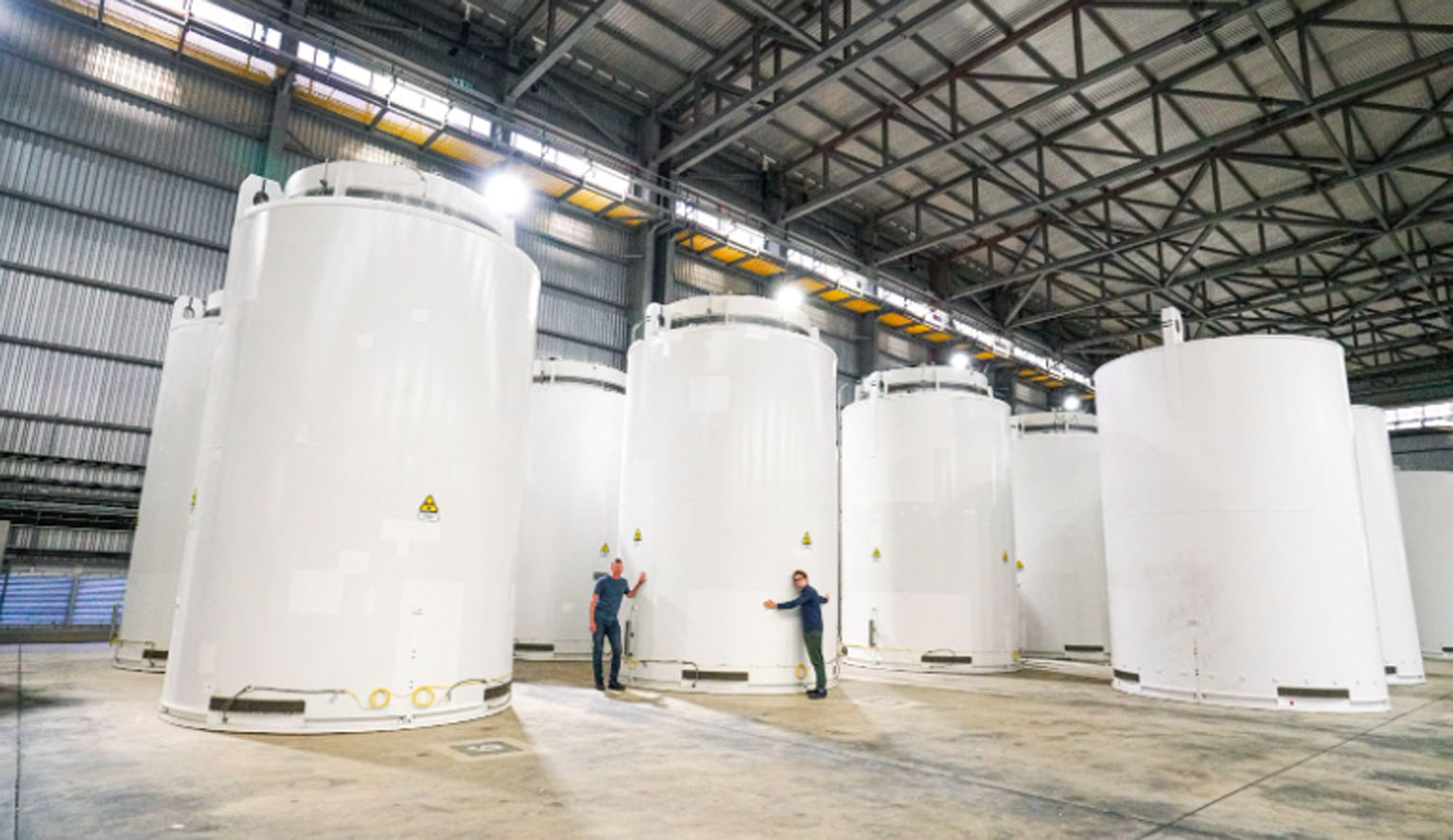The Hanford Site’s B Complex area tank farm containing waste created during the production of plutonium at the site. (Photo: DOE)
After nearly three years of discussions and more than 60 mediation sessions, the Department of Energy, Washington State Department of Ecology, and the Environmental Protection Agency announced that they have reached a conceptual agreement on revising plans for managing millions of gallons of waste stored in tanks at the Hanford Site near Richland, Wash.
A CAST Specialty Transportation truck delivering TRU waste packages to WIPP. (Photo: DOE)
The Department of Energy’s Waste Isolation Pilot Plant (WIPP) recently marked a milestone after its drivers exceeded 16 million safe miles without a serious accident or injury—equivalent to 33 round trips to the moon or more than 642 trips around the world, the DOE’s Office of Environmental Management announced.
SHINE’s Mo-99 production building under construction in October 2022. (Photo: SHINE)
Fusion development company SHINE Technologies announced that it will begin offering radiation effects testing in a dedicated facility on the company’s Janesville, Wis., campus later this year. SHINE will use high-energy fusion neutrons to test mission-critical components that are susceptible to radiation-harsh environments on behalf of its aerospace and defense customers.
The Diablo Canyon nuclear power plant.
The Nuclear Regulatory Commission announced that an agency licensing board will hold oral arguments in a challenge to Pacific Gas and Electric’s application to renew its license for the Diablo Canyon independent spent fuel storage installation in California.
The arguments, which will be open to the public, will be heard by an NRC Atomic Safety and Licensing Board on May 24 beginning at 1 p.m. eastern time.
Photos taken inside Hanford’s Tank AX-101 before workers started removing radioactive and chemical waste from it in January. As of April 18, crews have removed 35 percent of the tank waste. (Photos: DOE)
The Department of Energy’s Office of Environmental Management (EM) said in an April 18 release that workers have so far removed almost 150,000 gallons, or about 35 percent, of the radioactive and chemical waste from Tank AX-101 at the department’s Hanford Site near Richland, Wash. Retrieval from this tank began in January.
Demolition of the Portsmouth Gaseous Diffusion Plant’s X-326 building was completed in June 2022. (Photo: Fluor-BWXT Portsmouth)
As part of its ongoing cleanup work, the Department of Energy’s Office of Environmental Management is looking into the potential reuse of approximately 6,400 tons of radiologically surface-contaminated nickel that has been removed from the Portsmouth Gaseous Diffusion Plant in Ohio. DOE-EM began decommissioning the Portsmouth plant, one of three Cold War–era gaseous diffusion plant in the United States, in 2011.
A health-care technician performs a carotid artery scan on an SRS employee during the 2023 Wellness Fair at the site. (Photo: SRNS)
Savannah River Nuclear Solutions, the managing and operating contractor at the Department of Energy’s Savannah River Site near Aiken, S.C., was recognized by the American Heart Association for its commitments to employee health and well-being. The company received a gold level, as measured by the association’s 2022 Workforce Well-being Scorecard.
Hanford’s Waste Treatment and Immobilization Plant, also known as the Vit Plant. (Photo: Bechtel National)
The Department of Energy’s Office of Environmental Management awarded a 10-year contract worth up to $45 billion to Hanford Tank Waste Operations and Closure (H2C) of Lynchburg, Va., to oversee the management of liquid radioactive tank waste at the DOE’s Hanford Site in southeastern Washington state.
The Kewanee nuclear power plant is located along the shore of Lake Michigan. (Photo: EnergySolutions)
EnergySolutions subsidiary KewauneeSolutions is hoping to begin site restoration work at the closed Kewaunee nuclear power plant in Wisconsin later this year and has submitted a request to the Nuclear Regulatory Commission to use the plant’s decommissioning trust fund to do so.
Report author Mark Lynas and RePlanet’s Joel Scott-Halkes stand next to a canister of spent nuclear fuel at the Sizewell plant in the United Kingdom. (Photo: RePlanet)
A new report from the environmental advocacy group RePlanet makes the case for recycling used nuclear fuel for use in advanced power reactors. According to the report, What a Waste: How fast-fission power can provide clean energy from nuclear waste, by using current inventories of used fuel and depleted uranium stocks in Europe and the United Kingdom, fast breeder reactors could generate between 600 and 1,000 years of carbon-free electricity for the entire European Union.
William “Ike” White addresses the audience at INTEC, which gathered to celebrate the completion of the spent fuel wet-to-dry project at the INL site. (Photo: DOE)
At Idaho National Laboratory, Department of Energy leaders joined tribal, state, and local officials; contractors; and workers on March 28 to mark a recent milestone with the state of Idaho nearly 25 years in the making. The milestone was the completion of a spent fuel wet-to-dry project more than nine months ahead of a 1995 Idaho Settlement Agreement deadline.
Two British Class 88 locomotives transport a nuclear waste flask wagon across Great Britain. (Photos: NTS)
Since its formation in 2005, the United Kingdom’s Nuclear Decommissioning Authority (NDA) has been tasked with ensuring that the U.K.’s nuclear legacy sites are decommissioned and cleaned up safely, securely, cost-effectively, and in ways that protect the people and the environment.




 The Nuclear Decommissioning Authority, the governmental organization responsible for the cleanup and decommissioning of the United Kingdom’s 17 nuclear sites, has released its business plan for the fiscal years running from April 1, 2023, through March 31, 2026. The plan provides a summary of the activities and progress the NDA expects to make at its nuclear sites over the next three years.
The Nuclear Decommissioning Authority, the governmental organization responsible for the cleanup and decommissioning of the United Kingdom’s 17 nuclear sites, has released its business plan for the fiscal years running from April 1, 2023, through March 31, 2026. The plan provides a summary of the activities and progress the NDA expects to make at its nuclear sites over the next three years.









